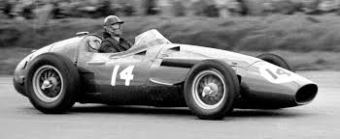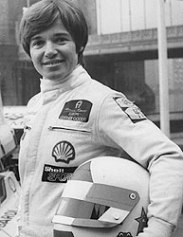
Maria Teresa de Filippis, the first woman to drive in Formula 1. Here she is driving a Maserati 250F IN 1958.
Grand Prix racing has never been a sport segregated along the lines of sex. Before Formula 1 even existed, in the inter-war period women raced equally alongside men in the most dangerous machines the sport has ever seen. Yet for the last two decades women have been absent from Formula 1. Daniel Paddock investigates the case of Formula 1’s missing heroines.
It has been over 21 years since a woman last entered a Formula 1 Grand Prix. That weekend in Brazil, the third round of the 1992 World Championship, the Italian female racing driver Giovanna Amati failed to qualify for a race for the third consecutive time. The once great Brabham team for which she drove was in its death throes, and when Giovanna failed to deliver on her promised sponsorship money they gave her the boot, replacing her with a relatively unknown driver at the time, named Damon Hill.

Giovanna Amati, the fifth and last woman to drive in Formula 1, pictured here in the Brabham BT60B in Brazil, 1992.
Amati was laughed out of Formula 1, deemed as just another failed PR attempt and seen as a final roll of the die by a dying Brabham team desperate for any publicity that it could get. Remarkably, Amati was only the fifth woman to enter a Formula 1 Grand Prix since the formation of the World Championship in 1950. Fellow Italian, Lella Lombardi was the only one of those women to ever record a points finish, at a shortened Spanish Grand Prix in 1975, for which she received half a point for a 6th place finish.
It is almost impossible to look at that 21 year gap and not wonder why it is that no women have made it into Formula 1 since Amati’s short lived career in 1992. Is it as Sir Sterling Moss, ‘the greatest driver never to win a world championship’ suggested last month? Do women not have the mental aptitude to compete competitively in Formula 1? Is it that woman face institutionalised sexism in the world of motorsport that means that they are held back from achieving their goals? Alternatively is it a simple matter of a lack of participation from young girls that has created this 21 year void in Formula One? Or, perhaps there’s another reason entirely.
Edd Straw, F1 Editor of AUTOSPORT magazine and http://www.autosport.com, quite quickly dismissed the idea that the absence of women from Formula 1 had something to do with them somehow being any less mentally competent than men. Speaking of Sir Stirling Moss, he said:
“This was a guy who was born in the late 1920s, he’s about 83. So I’m not surprised by his comments. I do think he is incorrect and that it’s an old fashioned position to take, but if you take that opinion in terms of when he was actually racing in the 50s and 60s then that would actually be a pretty enlightened view. “
Instead, Straw explained how he thought that the low participation levels of females in junior motorsport went some way to suggest why no women had made it to Formula 1 in the last two decades. He said: “If you take the number of females who start in karting with aspirations of having a Formula 1 career it’s very much a minority. I think the important thing from the sports point of view is to make sure that for those who do it’s not seen as a closed shop for a male environment, and that female drivers are treated as racing drivers, rather than a kind of a curiosity.”
Will Buxton, NBC’s Pit Lane Reporter, gave a very similar answer when posed with the same question. He said:
“If you look at the percentage of girls in karting, it’s no wonder we haven’t seen a woman in F1 for such a long time.”
“Only the smallest percent make it out of karts (boys or girls), and a smaller number still make it out of entry level single-seaters. That number is reduced further the higher up the ladder you go. So, if a girl makes it to the top, she’ll have to be something very special.”
Both Edd and Will also spoke of the damage that has been dealt in recent time by the tendency of the media to hype up the performances of mediocre female drivers.
Edd commented: “That’s one of the things that has frustrated me in motor racing recently.”
“When you see a female driver doing okay, reasonably well, fairly competent but then getting massively talked up, as if being a solid mid pack runner suddenly makes you F1 material, just because you’re female.”
“I find that a little bit patronising in a way, as if it’s remarkable that a female driver can be an okay driver at this level.”
In many cases this build-up of hype actually does more harm than good as it creates a false sense of expectation around the driver, putting more pressure on their shoulders to perform. Driver’s profiles will be on the rise so if their results do not then meet people’s expectations it damages both their own confidence and their ability to progress in their career. However, this is not something that affects only females in the sport.

Zoe Wenham, currently racing in the GT4 Class of the British GT Championship.
(Photo Credit: Marc Waller)
Zoe Wenham, a 19-year-old racing driver who started karting at 9-years-old after being introduced to racing by her father and is currently competing in the GT4 category, is perhaps better suited than anybody to explain the difficulties that she has faced as a female on the climb up the motorsport ladder.While Zoe has set her sights on the Le Mans 24 Hours, rather than the single-seater route, she described some of the difficulties of being female in a predominantly male environment.
“I think it’s particularly difficult when you first start out in Karting as a girl.”
“Karting is so fraught and tough, and you’re racing with all of these boys, all of different ages and they just think you shouldn’t be there. You should be playing with ponies and stuff like that.”
“You’ll go out in a kart for the first time and be demoralised because you’re being beaten by some boys who’ve been there for a year. As you grow up that does change, in fact I think it’s easier when you move up from Karting.”
Zoe also pointed to a lack of female role models in the sport as a big issue for young female aspiring racing drivers. She said:
“Most girls don’t have any role models. They’ll go to a kart track and there may be one girl there if they are lucky.”
“I think that’s the biggest barrier, not having roles models in the sport and at the venues, people who the girls can look up to and aspire to. I really hope that Susie (Wolff) can get onto the grid.”
Zoe’s comments highlight a vicious circle, which certainly must have had an effect on young female racing drivers in the last 20 years. Single-seater racing, with Formula 1 at its peak, has never had a history of female success, and certainly none recently, which has left young female racing drivers with no role models to aspire to.
One claim that is sometimes offered up as an explanation for the lack of female success and participation in top level motorsport is the apparent physical disadvantages that women face in regards to the sport, for example a lack of physical strength. Top level motorsport and Formula 1 in particular are highly demanding on the human body, with drivers in Formula 1 subjected to upwards of 5-6G (five times the weight/force of gravity, g-force) through some corners.
However, Zoe argues that while there is a barrier to be overcome for women from a physical stand point, it is not something that women would be unable to achieve if they were given the opportunity to do so. She said: “If a female gets the chance to be in Formula 1 then they’ll know how to target their training. They’ll now that they will need a very strong neck and that’s maybe something that females lack as we aren’t generally quite as muscular as men, but we could be as physically strong if someone was in that situation.”
Edd Straw also dismissed this idea of women being physically disadvantaged in motorsport, he said: “I can think of no fundamental reason why not.”
“If you look at some of the kinds of jobs that females are doing, thee are female fighter pilots and females on the front line in the military. I can’t see any compelling reason why physically women are not able to do it. Formula 1 fitness is very intense but it is very specific in terms of the demands, pure strength isn’t quite so relevant.”
He even highlighted that women’s typically smaller height could potentially be an advantage as a racing driver.
Finding suitable funding was another difficulty that Zoe had been forced to overcome in her dream to make it to Le Mans, she said: “I think the issue is that if you use a woman to promote a manly brand, then unless she is naked that doesn’t really work in the same way that a man would. Think of Jenson Button in a Hugo Boss advert for example. Then the issue with female brands is that most people associated with that brand don’t really watch motorsport so they are less willing to get involved so it’s certainly tough.”
Edd Straw agreed on the challenge of finding funding, but not just for young female racing drivers, but for males as well.
“Maybe you could say that it is easier in some ways, as it gives you a unique selling point, as one of perhaps two female drivers trying to make it in single-seater, but, when it comes down to it sponsorship and backing, it’s incredibly difficult for anybody to find.”
Wiill Buxton reinforced the difficulties of finding a budget in these times, and shared his disbelief at some of those female racers who had been left on the side-lines. He said:
“Look at Alice Powell. She won the Formula Renault BARC championship. How many of her peers can claim to have put a championship together? Very few, and yet she struggles for backing.
“You look at Vicky Piria. She clearly has talent, she is young. Staggeringly pretty, in short she is a PR dream, and yet she can’t get funding. So that’s a wall that needs to be knocked down.”


